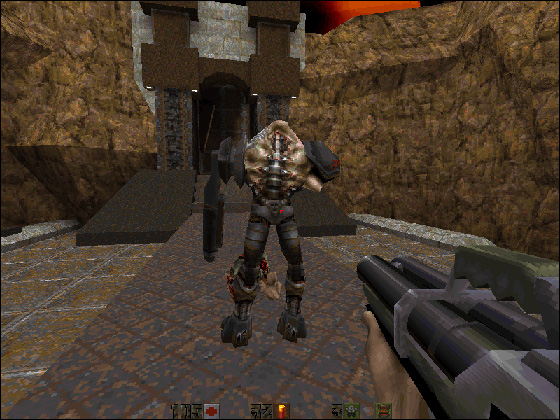Technology, Mobility and Level Design in Quake II
September 14th, 2010
Quake II, as we’ve established of most genre-defining FPS games, is marked by its relationship to technology. So in order to understand id’s paradigm of technology creating and limiting FPS gameplay, let’s examine influence of technology over gameplay in Quake II.
Unlike FPS games a few years after its release, Quake II could not rapidly track small body parts in fast motion, namely the head, meaning that, without insta-kill head shots, shoot outs were longer and with only a limited number of AI at the one timze. id supported this technical dictation by ramping up the amount of damage which the player and their Strogg foes could sustain, thereby extending the duration of gunplay and making Quake II a game of manoeuvrability within arena designed levels.
(This design also works in well within the technical constraints, in that quicker deaths would require greater supplementation of enemies and therefore an increased likelihood of more enemies on screen at once, that of which the game couldn’t handle in a 3D environment. Furthermore, more hit points gives narrative credence to the Strogg’s being made of metal and other industrial fibre. By limiting the complexity of confrontations, the intelligent AI had a platform to be noticed).
But what do longer shoot outs mean exactly? Well, it means that standing still and firing off rounds of ammo won’t do much good. You’re rival will be acting likewise—and they’re designed so that once they lock-on they shoot liberally, never mind that they won’t run out of ammunition either—and you’ll both be running out of health which you can’t afford to do, so dodging, ducking and hiding become essential devices in overcoming enemies and defeating the game. The systems of shooting and movement support this type of environment and movement-centric play. Movement, for one, is quick, fluid and an advantage that you have over the slow, predictable enemy movement patterns in the game. There is also no reloading required whatsoever in Quake II and ammunition is plentiful which itself practically asserts the unimportance of arms in lieu of tactical use of the level design. Furthermore, there is no real tactical advantage in shooting certain body parts, so there’s little advantage in standing still and being too precise.
Initially, in the early levels of Quake II, which are less like a labyrinth and more open-ended, the player only needs to focus on their proximity to the foes around them. In later levels, where players are drawn into a series of arena-esque levels, the player must keep their distance while also leveraging the environment to exploit the weaknesses in the sophisticated (but decidedly predictable) enemy attack patterns. So, the levels are built to suit this type of play also.
(Backtracking from how technicality affects play behaviour and into how it affects other parts of the game. Similarly to Resident Evil 4, Quake II limits it colour palette to increase technical efficiency elsewhere, namely the fluid movement and steady performance. Also, it is the technical ability (and inability) of Quake II which structures it as a series of connected channels, bound by a level structure).
Conclusion
id established the first person shooter genre under the paradigm that technology creates game design. Quake II is an id first person shooter whose design is dictated by its technical ability and inability. As such, Quake II scales the shooting to only a few combatants at the one time and therefore emphasises the principles of mobility and tactical skills within the well designed levels.
Extended Readings
Coelacanth: Lessons from Doom





 Game Design Companion: A Critical Analysis of Wario Land 4 - $7.99
Game Design Companion: A Critical Analysis of Wario Land 4 - $7.99 Level Design: Processes and Experiences
Level Design: Processes and Experiences Speed Boost: The Hidden Secrets Behind Arcade Racing Design - $5.99
Speed Boost: The Hidden Secrets Behind Arcade Racing Design - $5.99 Adventures in Games Analysis: Volume I - $5.99
Adventures in Games Analysis: Volume I - $5.99







